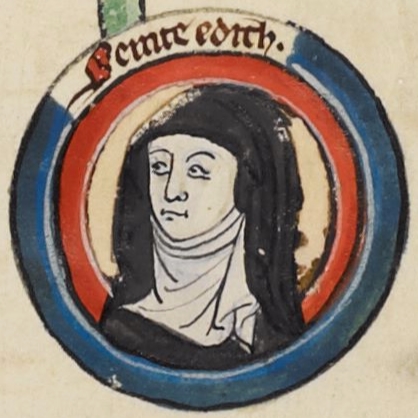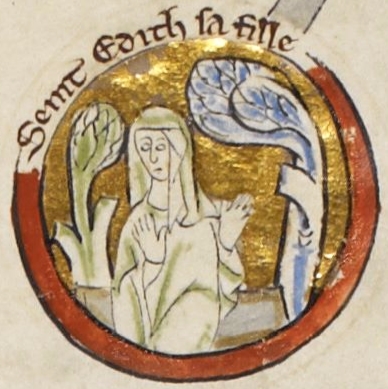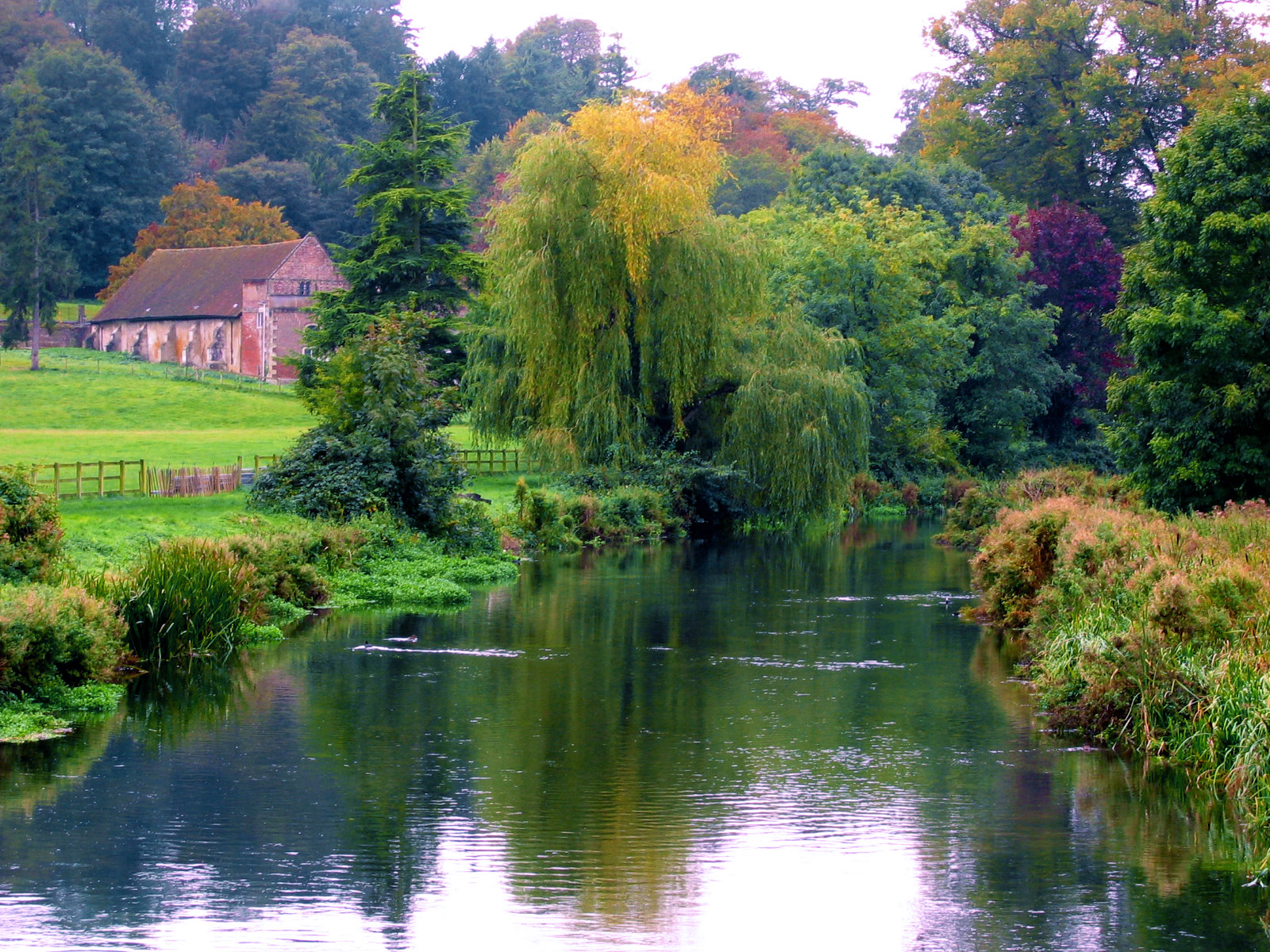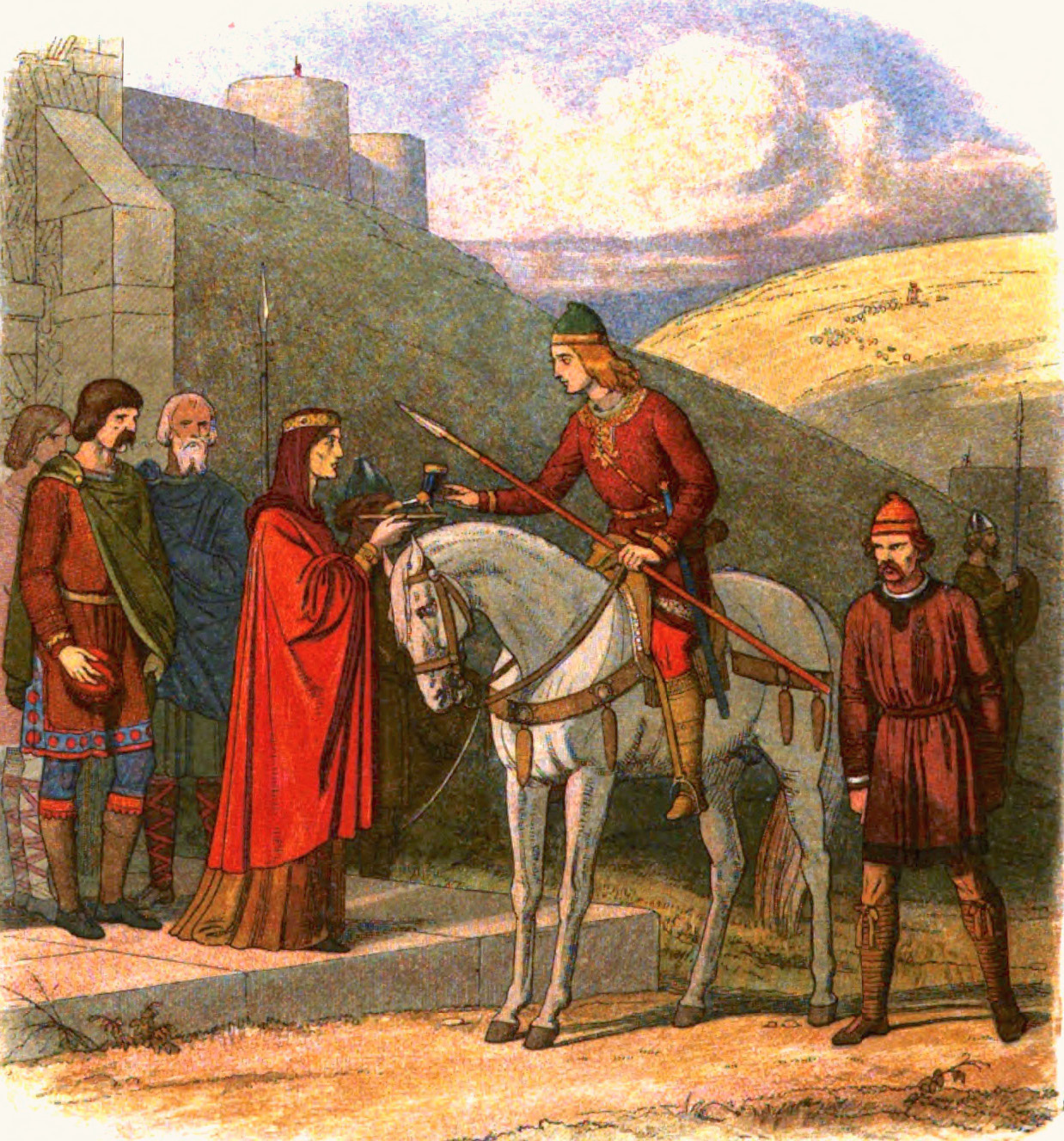|
Wulfthryth Of Wilton
Wulfthryth, also known as Wilfrida (died 1000), was a Catholic female saint and abbess from Anglo-Saxon England who was venerated locally in Wiltshire. Primary sources Wulfthryth is known to history through several sources, including the hagiography of the Secgan Manuscript, John of Worcester’s Chronicle, William of Malmesbury, Osburn’s ''life of Dunstan'', the Life of St Wulfthryth found in ''The Wilton Chronicle'', A Royal Charter of King Edgar to Wulfthryth, and the ''Vita Edithae'' by Goscelin. The medieval source record her as living an exemplary life of sanctity and virtue and her virtues were often contrasted to the machinations of Edgar's second (third?) wife, Ælfthryth. Life Wulfthryth was an English noblewoman, a cousin of Wulfhild, born about 937, whom King Edgar of England carried off from the nunnery at Wilton Abbey and took to his residence at Kemsing, near Sevenoaks. While in Kent, Wulfthryth gave birth to a daughter, Edith. After at least ... [...More Info...] [...Related Items...] OR: [Wikipedia] [Google] [Baidu] |
Roman Catholic Church
The Catholic Church, also known as the Roman Catholic Church, is the largest Christian church, with 1.3 billion baptized Catholics worldwide . It is among the world's oldest and largest international institutions, and has played a prominent role in the history and development of Western civilization.O'Collins, p. v (preface). The church consists of 24 ''sui iuris'' churches, including the Latin Church and 23 Eastern Catholic Churches, which comprise almost 3,500 dioceses and eparchies located around the world. The pope, who is the bishop of Rome, is the chief pastor of the church. The bishopric of Rome, known as the Holy See, is the central governing authority of the church. The administrative body of the Holy See, the Roman Curia, has its principal offices in Vatican City, a small enclave of the Italian city of Rome, of which the pope is head of state. The core beliefs of Catholicism are found in the Nicene Creed. The Catholic Church teaches that it is th ... [...More Info...] [...Related Items...] OR: [Wikipedia] [Google] [Baidu] |
Saint Edith Of Wilton
Edith of Wilton ( – 16 September 984) was an English nun, saint, and the only daughter of Edgar, King of England (r. 959–975), and Saint Wulfthryth, who later became abbess of Wilton Abbey. Edgar most likely abducted Wulfthryth from Wilton; when Edith was an infant, Wulfthryth brought her back to the convent, where they both spent the rest of their lives. Like her mother, Edith was educated at Wilton; she chose to enter the religious life from a very early age, although there is some controversy regarding if she was a nun or a secular member of the Wilton community. Goscelin completed her hagiography in ; he reports that Edith "always dressed magnificantly" because her status as a member of the royal family obligated her to fulfill certain roles to ensure the continued royal patronage of the Wilton community. Goscelin's main sources for his ''Vita'' were the oral testimony of the Wilton nuns and their abbess, as well as "from existing books", and it was dedicated to Lanfranc ... [...More Info...] [...Related Items...] OR: [Wikipedia] [Google] [Baidu] |
Penance
Penance is any act or a set of actions done out of Repentance (theology), repentance for Christian views on sin, sins committed, as well as an alternate name for the Catholic Church, Catholic, Lutheran, Eastern Orthodox, and Oriental Orthodox sacrament of Reconciliation or Confession. It also plays a part in confession among Anglicanism, Anglicans and Methodism, Methodists, in which it is a Sacrament, rite, as well as among other Protestants. The word ''penance'' derives from Old French and Latin ''paenitentia'', both of which derive from the same root meaning repentance, the desire to be Forgiveness, forgiven (in English see contrition). Penance and repentance, similar in their derivation and original sense, have come to symbolize conflicting views of the essence of repentance, arising from the controversy as to the respective merits of Faith in Christianity, "faith" and "good works". Word derivations occur in many languages. According to dictionary definitions, the primary mea ... [...More Info...] [...Related Items...] OR: [Wikipedia] [Google] [Baidu] |
Saint
In religious belief, a saint is a person who is recognized as having an exceptional degree of Q-D-Å , holiness, likeness, or closeness to God. However, the use of the term ''saint'' depends on the context and Christian denomination, denomination. In Catholic Church, Catholic, Eastern Orthodox Church, Eastern Orthodox, Anglican Communion, Anglican, Oriental Orthodox, and Lutheranism, Lutheran doctrine, all of their faithful deceased in Heaven are considered to be saints, but some are considered worthy of greater honor or emulation. Official ecclesiastical recognition, and consequently a public cult of veneration, is conferred on some denominational saints through the process of canonization in the Catholic Church or glorification in the Eastern Orthodox Church after their approval. While the English word ''saint'' originated in Christianity, History of religion, historians of religion tend to use the appellation "in a more general way to refer to the state of special holiness t ... [...More Info...] [...Related Items...] OR: [Wikipedia] [Google] [Baidu] |
Sevenoaks
Sevenoaks is a town in Kent with a population of 29,506 situated south-east of London, England. Also classified as a civil parishes in England, civil parish, Sevenoaks is served by a commuter South Eastern Main Line, main line railway into London. Sevenoaks is from Charing Cross, the traditional centre of London. It is the principal town of the Sevenoaks (district), Sevenoaks district, followed by Swanley and Edenbridge, Kent, Edenbridge. A settlement was recorded in the 13th century, when a market was established. Construction of Knole House in the 15th century helped develop the village. Sevenoaks became part of the modern communications network when one of the early toll road, turnpikes was opened in the 18th century; the railway was relatively late in reaching it. In the 21st century, it has a large Commuter town, commuting population. The nearby Fort Halstead defence installation was formerly a major local employer. Located to the south-east of the town is Knole Park, wit ... [...More Info...] [...Related Items...] OR: [Wikipedia] [Google] [Baidu] |
Kemsing
Kemsing is a village and civil parish in the Sevenoaks district of Kent, England. The parish lies on the scarp face of the North Downs, 20 miles south east of Central London, north east of Sevenoaks. Also in the parish are the hamlets of Heaverham, to the east, and Noah's Ark to the south. The population of the civil parish in 2001 was 4,014 persons, increasing to a population of 4,218 at the 2011 Census. History Kemsing was the birthplace, in between AD 961 and 964, of Saint Edith of Wilton, a daughter of the Anglo-Saxon King Edgar I. The well at the centre of the village is dedicated to her, a plaque on the wall recording the local legend that her saintly presence has given the water healing properties. Given the village connection with St. Edith it is perhaps surprising that the parish church, Saxon in origin, is however dedicated to St Mary the Virgin. Another local legend states that the knights who murdered Archbishop Thomas Becket rode through Kemsing on their way ... [...More Info...] [...Related Items...] OR: [Wikipedia] [Google] [Baidu] |
Wilton Abbey
Wilton Abbey was a Benedictine convent in Wiltshire, England, three miles from Salisbury, probably on the site now occupied by Wilton House. It was active from the early tenth century until 1539. History Foundation Wilton Abbey is first recorded in the 930s, but a 15th-century poem dates its foundation to the late 8th century by Weohstan, ealdorman of Wiltshire, and his widow Alburga is said to have been its abbess. This claim has been accepted by some historians, but it is rejected by the ecclesiastical historian, Sarah Foot, who describes it as a new foundation in the tenth century. The story is also dismissed by the historian Elizabeth Crittall. Alburga (or Æthelburh) is said to have been the half-sister of King Ecgberht of Wessex, but she is not mentioned in biographies of Ecgberht. Anglo Saxon era The community was to number 26 nuns. It was attached to St Mary's Church. Two daughters of king Edward the Elder and Ælfflæd, Eadflæd and Æthelhild, probably joined ... [...More Info...] [...Related Items...] OR: [Wikipedia] [Google] [Baidu] |
Nunnery
A convent is a community of monks, nuns, religious brothers or, sisters or priests. Alternatively, ''convent'' means the building used by the community. The word is particularly used in the Catholic Church, Lutheran churches, and the Anglican Communion. Etymology and usage The term ''convent'' derives via Old French from Latin ''conventus'', perfect participle of the verb ''convenio'', meaning "to convene, to come together". It was first used in this sense when the eremitical life began to be combined with the cenobitical. The original reference was to the gathering of mendicants who spent much of their time travelling. Technically, a monastery is a secluded community of monastics, whereas a friary or convent is a community of mendicants (which, by contrast, might be located in a city), and a canonry is a community of canons regular. The terms abbey and priory can be applied to both monasteries and canonries; an abbey is headed by an abbot, and a priory is a lesser dependent hou ... [...More Info...] [...Related Items...] OR: [Wikipedia] [Google] [Baidu] |
Wulfhilda Of Barking
Wulfhilda, also known as Wulfhild and Wulfreda among several other names (c. 940-c. 996) was an Anglo-Saxon abbess and a saint in the Roman Catholic Church and the Eastern Orthodox Church. Life Wulfhilda was the daughter of a Wessex nobleman named Wulfhelm. She was raised and educated by the Benedictine nuns of Wilton Abbey and joined their community when she became of age. Around 970, she was appointed as abbess of Barking Abbey by Edgar the Peaceful. Under Wulfhilda's leadership, the monastery flourished and was greatly expanded. Wulfhilda herself donated 20 villages to the abbey and established another monastery at Horton in Kent. According to Goscelin of Saint-Bertin, the nuns at Barking laid complaints against their abbess Wulfhilda, and the English queen Ælfthryth deposed her, only to reinstate her twenty years later. The demotion might have been the result of jealousy as Ælfthryth's husband Edgar may have had romantic interest in Wulfhilda. Goscelin also described Wulfh ... [...More Info...] [...Related Items...] OR: [Wikipedia] [Google] [Baidu] |
Nobility
Nobility is a social class found in many societies that have an aristocracy (class), aristocracy. It is normally ranked immediately below Royal family, royalty. Nobility has often been an Estates of the realm, estate of the realm with many exclusive functions and characteristics. The characteristics associated with nobility may constitute substantial advantages over or relative to non-nobles or simply formal functions (e.g., Order of precedence, precedence), and vary by country and by era. Membership in the nobility, including rights and responsibilities, is typically Hereditary title, hereditary and Patrilinearity, patrilineal. Membership in the nobility has historically been granted by a monarch or government, and acquisition of sufficient power, wealth, ownerships, or royal favour has occasionally enabled commoners to ascend into the nobility. There are often a variety of ranks within the noble class. Legal recognition of nobility has been much more common in monarchies, ... [...More Info...] [...Related Items...] OR: [Wikipedia] [Google] [Baidu] |
Edith Of Wilton
Edith of Wilton ( – 16 September 984) was an English nun, saint, and the only daughter of Edgar, King of England (r. 959–975), and Saint Wulfthryth, who later became abbess of Wilton Abbey. Edgar most likely abducted Wulfthryth from Wilton; when Edith was an infant, Wulfthryth brought her back to the convent, where they both spent the rest of their lives. Like her mother, Edith was educated at Wilton; she chose to enter the religious life from a very early age, although there is some controversy regarding if she was a nun or a secular member of the Wilton community. Goscelin completed her hagiography in ; he reports that Edith "always dressed magnificantly" because her status as a member of the royal family obligated her to fulfill certain roles to ensure the continued royal patronage of the Wilton community. Goscelin's main sources for his ''Vita'' were the oral testimony of the Wilton nuns and their abbess, as well as "from existing books", and it was dedicated to Lanf ... [...More Info...] [...Related Items...] OR: [Wikipedia] [Google] [Baidu] |
Ælfthryth (wife Of Edgar)
Ælfthryth ( – 1000 or 1001, also Alfrida, Elfrida or Elfthryth) was Queen of the English from her marriage to King Edgar in 964 or 965 until Edgar's death in 975. Ælfthryth was the first wife of an English king known to have been crowned and anointed as queen. She had two sons with Edgar, the ætheling Edmund (who died young) and King Æthelred the Unready. Ælfthryth was a powerful political figure and possibly orchestrated the murder of her stepson, King Edward the Martyr, in order to place her son Æthelred on the throne. She appeared as a stereotypical bad queen and evil stepmother in many medieval histories. Early life Ælfthryth was the daughter of Ealdorman Ordgar. Her mother was a member of the royal family of Wessex. The family's power lay in the west of Wessex. Ordgar was buried in Exeter and his son Ordwulf founded, or refounded, Tavistock Abbey. Ælfthryth was first married to Æthelwald, son of Æthelstan Half-King as recorded by Byrhtferth of Ramsey ... [...More Info...] [...Related Items...] OR: [Wikipedia] [Google] [Baidu] |

.jpg)






